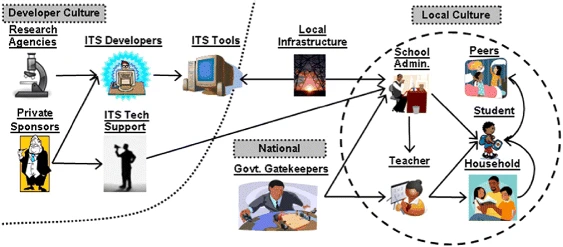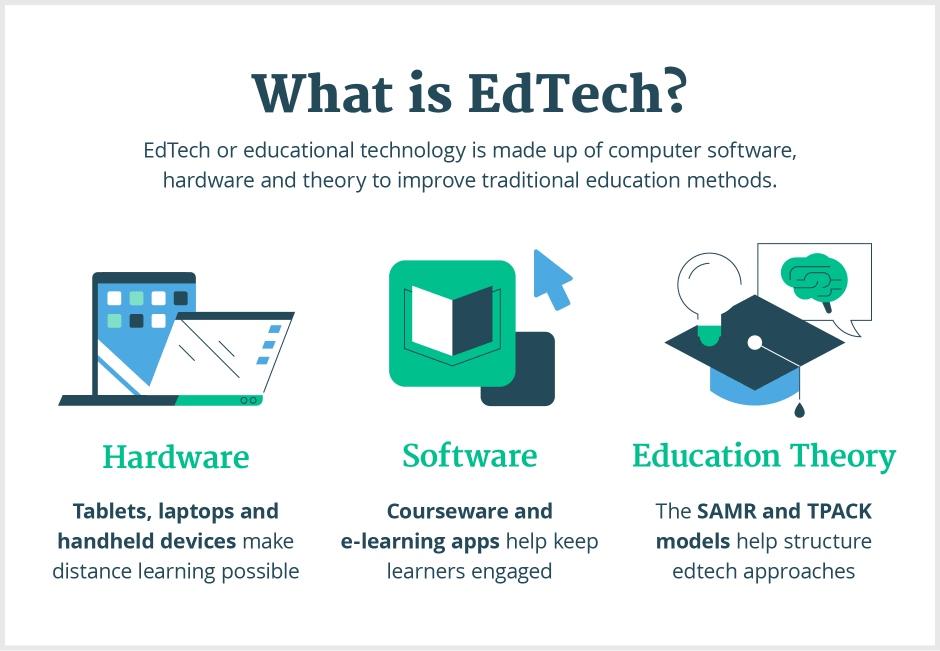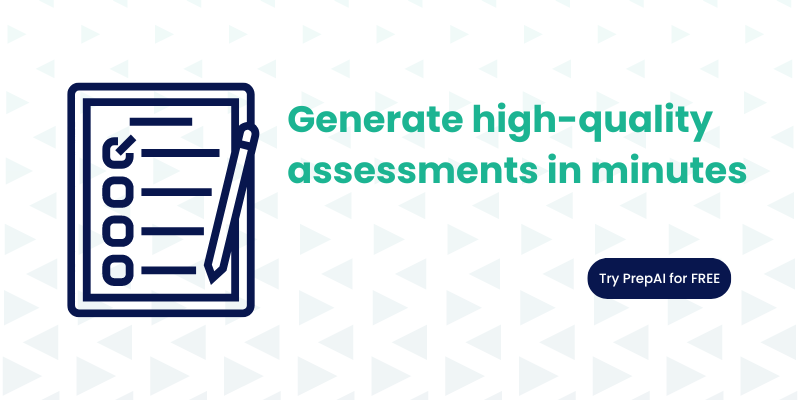The global e-learning market valuation is expected to hit the 370 bn USD mark by 2026 and studies reveal that using a proper mix of gaming and reading in the eLearning scenarios produces better results.
While the global EdTech market has been gaining momentum since the previous decade, as we move towards another pandemic-struck year, the trends seem to be in huge favor for scholastic or K-12 education as well.
In some parts of the world, they have access to learning apps and devices right from when they start school, whereas the economic disparity and difference in the level of internet penetration in the other parts of the world is spurring a number of challenges as well.
From increasing safe internet access for the K-12 learners to offering AI-powered or AR/VR-powered learning to compensate for a proper classroom experience are making waves across the globe. Further, cybersecurity, facilitation of digital learning tools, and interactive learning solutions for K-12 learners are also some of the challenging aspects.
Hence, the future scope of K-12 EdTech is immense and with the increasing popularity of the eLearning tech such as AI, VR, AR, Big Data, and open learning, the industry is in for a huge revolution!
Below, we discuss some of the top K-12 EdTech trends to watch in 2023, but before proceeding, let us have an overview of K-12 EdTech.
What is K-12 EdTech: Understanding the Ecosystem
The following image offers a visual representation of the entire ecosystem for intelligent tutoring systems:
While the technology stays on the developer or vendor side, the Government policymakers and local infrastructure connect it with the final user or the education stakeholders.
Now, when we talk about the K-12 EdTech, the type of content, the UI of the final product, and the value proposition changes significantly, as the industry has to cater to young and budding learners.
Hence, instead of offering exhaustive and thoughtlessly tech-powered learning solutions, the businesses operating in the industry have to come up with proper protocols and EdTech strategies to solve the pain points of the learners.
Finally, the industry must consider the usability of the software solutions for the teacher, parents, and school administration.
Creating a self-propelling ecosystem for imparting modern education powered by advanced technologies will be realized gradually, because it will require a comprehensive blending of multiple entities, as shown in the following visual:
Now that we have had an overview of K-12 EdTech let us move on to discuss the major trends for 2023 in the industry.
Top K-12 Educational Technology Trends to Watch in 2023
1. AI-Powered Learning
Recent market reports suggest that the global AI adoption in the education market will demonstrate a CAGR of 47% till 2023, and the total valuation will reach the 3.68 bn USD mark.
McKinsey revealed that currently 49% of the working hours of a teacher are spent in direct interaction with the students and managing the various aspects of their education, behavioral growth, etc.
Technologies such as AI can help the teachers in reallocating their time towards activities that directly support learning, as shown in the following visual:
Using AI will allow the teachers to offer more targeted and personalized education and evaluation modules for students with different learning and understanding abilities. AI-based automation in the teaching profession, such as PrepAI question paper generator, will also help in reducing the educational inequalities in society stemming from economic well-being and exposure to technology.
Some other use cases of AI in K-12 EdTech are:
- Multi-lingual translators
- Enhancing the experience and knowledge level of educators
- Improving the learning level of students
- Offering personalized learning
2. Cloud and Cybersecurity
Cloud computing in the education market is expected to grow with a CAGR of 25.6 % and the trends suggest that cloud is going to be a major facilitating technology for EdTech in K-12 learning as well.
Learning beyond the classroom boundaries, strong requirements of reducing the management’s burden, and competition among the academic institutions are the major drivers of the trend.
Some of the notable use cases of cloud in K-12 EdTech are:
- Seamless and effortless connectivity
- Scalability
- Cloud-based ERP systems
The recent trends in cloud computing and cloud-based services call for a revision of security postures to ensure that there are no loose points in the entire network to avoid falling prey to cyberattacks and malicious data thefts.
Hence, a rise in the use of cloud-based services will also fuel the cybersecurity trends as more and more educational institutions will look forward to having a secure ecosystem.
3. Asynchronous Learning for Diverse Learning
Stats suggest that when students get the freedom to learn as per their own schedules, they are more engaged with the study material and also make the most efficient use of the classroom time. Some common examples of asynchronous learning that are also being used across educational institutions are reading and writing assignments, pre-recorded lecture videos, video demonstrations, and group or individual projects.
With more and more schools opting for asynchronous learning to improve student engagement in class, the trend is going to revolutionize the K-12 education industry in the year ahead.
Notable use cases of asynchronous learning in K-12 EdTech:
- Students can learn at their own pace
- More engaging and demonstrative form of learning
- Using open sources for diverse learning
4. Digital Learning Tools
Digital learning tools helmed the responsibility of facilitating education via online classes across the entire world as the COVID-19 pandemic struck!
Apart from offering means for students and teachers to collaborate without much hassle and facilitating real-time collaboration for working on projects, these tools also spurred many critical changes in the K-12 education industry.
Nearly 75% of the K-12 educators used some form of remote teaching facilitated by digital learning tools, and 11% of them reported using this medium only since the pandemic.
Take a look at some more eye-opening stats that show the popularity of digital learning:
- 41% of the teachers will continue to use online quizzes even after the pandemic ends
- 32% of the teachers will opt for on-demand instructional videos in a post-pandemic learning scenario
- 24% of the teachers will continue using online tools to check academic integrity
Using online test platforms like PrepAI, the teachers can create different types of questions, such as MCQs, true/false, fill-ups, descriptive, etc., within minutes. As the tool allows the teachers to use the content for paper creation from multiple sources, it simultaneously provides the feature to conduct online tests with multiple candidates at once making the overall learning process easier and better.
Some notable use cases of digital learning tools in K-12 EdTech are:
- Digital presentation and written documents
- Online education material sourcing
- Interactive learning
5. More Accessible Learning
Accessibility to learning resources and educational material showed a spike when the world went into the sudden grip of the pandemic, as educators and students, both had to get the technology and the devices necessary for online classes.
Apart from making education technology more accessible, the trend also spurred the accessibility of educational material.
Recent studies also revealed that 45% of the parents would continue the online classes for their kids if possible, while 22% would prefer a hybrid model of learning with offline as well as online classes.
This creates a new chapter for accessible learning and assistive technologies for the same in the K-12 segment, where there is immense potential for accessibility.
Some of the notable use cases are:
- Internet access at homes and educational institutions for online learning
- Using open online educational resources for learning (Here also, smart tools like PrepAI can be of extreme importance)
- Alternative learning and evaluation methods for students with special needs or disabilities
6. Personalized Learning Experiences
Technologies such as AI, cloud computing, and digital learning tools empower educators to impart highly curated learning materials for young learners, especially the first and second graders, that are still experiencing the world of education with all the attention. As the students grow, they tend to develop preferences for certain subjects, topics, and modes of learning and expression.
This is where personalized learning proves to be of extreme importance.
Using digital learning tools to create digital profiles of students with insights into their strengths, weaknesses and creating a holistic learning module accordingly – teachers can accomplish much more in the personalized learning arena.
Smart AI-powered solutions like PrepAI – a smart question paper creator that allows the teachers to create different types of question papers of different complexities – make personalized learning easier for both – the teachers and the students.
Some notable use cases in K-12 EdTech are:
- Enhanced support for educators
- Enhanced learning and engagement for students
- Individualized instruction
- Interest-driven education and learning
7. Interactive Learning Will Be a Major Selling Point
The global smart learning market is all set to grow with a CAGR of 21% and stand at a valuation of 95.4 bn USD by 2026. Apart from a huge demand for an interactive learning atmosphere to modern data-driven Learning Management Software (LMS) is nudging educational institutions to invest in human capital, technological resources, and the overall smart learning market.
Hence, the digital learning tools and EdTech businesses in the K-12 segment are going to project their readiness with smart and intuitive LMS and expertise in interactive learning as a major selling point.
Some of the notable use cases are:
- Interactive learning for better understanding
- Visual learning for diverse instruction
- Smart and interactive technologies for personalized learning
8. AR and VR Utilization in Learning
The market forecasts for AR and VR utilization in learning predict a CAGR of 16.2% and a market value of 19.6 bn USD by 2023.
Earlier used for higher education and simulation of surgeries and various other medical treatments, the increasing need to offer personalized learning experiences and offering diverse education to students from a young age have propelled the technologies as a sure-shot trend to watch in K-12 EdTech in 2023.
AR and VR use cases in K-12 EdTech:
- Visualization and virtual representation of natural events etc
- Visual demonstration
- Understanding the structures, and landforms with a better visual simulation
9. Consistent Professional Development of Educators
As the education industry keeps on evolving and getting disrupted with technological advancements and innovation, there is a huge need to ensure that educators are ready to embrace the changes.
Right from the ability to use and help the young learners use the latest EdTech tools, equipment, and educational material, to understanding the tools for making the best possible use for instruction – the teachers have to be on their toes!
This is why the educational institutions have to ensure:
- Regular training and educating of teachers in relevance to EdTech
- Testing the teachers from time to time to ensure quality teaching
- Hiring new staff catering to the digital transformation, troubleshooting, and automation needs of the educational institutions
10. Nano-Learning Modules for Learning and Skill Enhancement
Micro and nano-learning modules will become all the more critical for imparting education as well as skill development in K-12 learners right from a young age. The educators will have access to a pool of small learning and skill development modules that they can assign to the students based on the analysis of their digital profiles.
They can also create separate pools of nano-learning modules for various age groups, allowing for better and more streamlined use of these modules.
Some of the most notable use cases of nano-learning modules in K-12 EdTech are:
- Targeted instruction keeping the future educational or occupational goals in mind
- Making skill acquiring and skill honing an easy step-by-step process
- Offering interest-specific learning modules in small packets for better understanding
Miscellaneous Trends in K-12 EdTech in 2023
Formative Assessment Solutions
Gone are the days of the tedious pen and paper tests where the evaluation of written tests used to be the only means of assessment or student evaluation. Teachers, with access to modern educational apps and digital learning tools, will be able to create different types of question papers digitally and leverage the formative assessment methodologies.
Formative assessment is more productive and relies on various activities, such as presentations, hands-on demonstrations or projects, activities, etc.
Hence, the methodology is going to be a major trend in the K-12 EdTech segment.
Online Education
As discussed above, online education is going to be a major trend even in the post-pandemic education industry. Apart from offering the ease of monitoring the kids from the comfort of their homes to keeping them safe from the pandemic, the online classes also help keep the costs of education down, such as conveyance, cafeteria, outings, etc.
Hence, instead of being a trend, online education is a new normal that is here to stay in the education industry, K-12 and beyond!
Embracing the Revolution: Taking the First Step Timely
As the education industry is in for a huge revolutionary wave with digital transformation and smart learning being the key drivers, making an early entry on the EdTech scene is a wise step.
The educational institutions can take the first right step by consulting the EdTech solution providers and discussing the needs and pain points in the EdTech segment as per their K-12 student pool.
Then, adopting the EdTech tools and the smart learning methodologies is the sure-shot way to make the most out of the trends discussed above.






